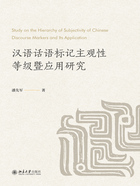
Abstract
This book is the comprehensive research of Chinese discourse markers for international Chinese teaching, trying to combine the aspect and use of language research, so that aspect can be established as use and aspect can be connected with use.
Discourse markers have been a hot topic in the study of Chinese language in recent years, and there have been fruitful research results, and its theory originates from Western linguistics. Chinese discourse markers research has formed a comprehensive study, individual research paradigm, but the applied research is still relatively weak, on Chinese as a second language learning and teaching research attention is not high, there is no impact of the results.
Procedural and subjectivity are two basic characteristics of discourse markers, the existing researches on the subjectivity of Chinese discourse markers mainly focus on its role in subjectivisation. Generally, the role of subjectivity is investigated from the formation of discourse markers. However, the research on the difference of subjectivity of discourse markers is not enough. Based on the previous studies, this study confirms that there are differences in the subjectivity of Chinese discourse markers and forms a hierarchical chain of subjectivity. The standard of grade division is put forward and demonstrated, according to the nature of discourse marker subjectivity, it is divided into(general)subjectivity, partial intersubjective subjectivity and intersubjectivity, the strength of subjectivity forms a hierarchical chain of“intersubjectivity > partial intersubjectivity >(general)subjectivity”, the relationship between discourse marker function and subjectivity, the generation of subjectivity and the role of subjectivism are discussed in detail.According to the hierarchical features of the subjectivity of discourse markers, we assume that the higher the subjectivity is, the more difficult it is to master Chinese as a second language discourse marker, at the same time, it is found that the difficulty system of Chinese discourse marker learning is formed with the subjectivity rank as the leading factor, and each factor has a roughly neat corresponding relationship, which clarifies the difficulties and key points of discourse marker learning. From the perspective of learning, we classify discourse markers, and discuss the role and status of discourse markers in Chinese learning, how to carry out teaching and other issues, and investigate the current syllabus, textbooks and so on.
The book is divided into nine chapters, the main contents of each chapter are as follows:
Chapter 1, is an Overview of the Study, which introduces the basic content and process of the study.
Chapter 2, a Review of the Basic Theory and Pedagogical Research on Discourse Markers, is a selective review of the previous studies on discourse markers.
Chapter 3, Discourse Markers and Their Subjectivity, discusses the definition of discourse markers, the subjectivity of discourse markers, the relationship between subjectivity and function, and the emergence of subjectivity on the basis of relevant studies at home and abroad. Futhermore, it elaborates on a special form of discourse markers in Chinese—the frame markers. This chapter serves as the foundational theoretical exposition for the entire book.
Chapter 4, a Study on the Subjectivity and Hierarchy of Discourse Markers for Teaching, proposes the hierarchy of subjectivity of discourse markers, demonstrates the relationship between the functions of discourse markers and subjectivity, and classifies discourse markers based on teaching. This chapter is the key part of the whole book, which analyzes the differences between the perspective and subjectivity of discourse markers, the relationship between the position of discourse markers and subjectivity, the stylistic features and subjectivity of discourse markers and their application in teaching.
Chapter 5, The Regularities and Functions of Discourse Markers and the Hierarchy of Subjectivity in Learning, investigates and analyzes the use of Chinese discourse markers by learners, verifies the hypothesis of the difficulty of subjectivity hierarchy in learning, proposes a learning difficulty system of discourse markers based on subjectivity hierarchy, and discusses the function and significance of discourse markers in Chinese communicative competence combined with subjectivity hierarchy.
Chapter 6, is the Investigation and Analysis of Discourse Markers in Chinese Language Teaching, which is mainly about the statistical analysis of discourse markers in syllabus and textbooks, the comparative analysis of the discourse markers appearing in textbooks and syllabus, and the discussion of the attribution of discourse marker in Chinese language teaching.
Chapter 7, Suggestions on Discourse Marker Teaching, puts forward the construction of discourse marker corpus, discourse marker teaching suggestions based on hierarchy, and takes a case as an example to investigate and design teaching.
Chapter 8, a Case Study of the Subjectivity of Discourse Markers, analyzes the subjectivity and its differences of the two types of discourse markers, that is, the speech discourse markers and the reproachful discourse markers, and the two concrete discourse markers of see what you say and true.
Chapter 9, Conclusion, summarizes the book and research prospects, but also to make a description of the shortcomings.